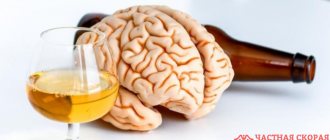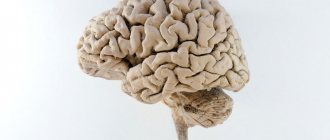Epileptic encephalopathy is a progressive disorder of brain function against the background of clinically manifested or non-convulsive epilepsy. More often found in childhood. In adults, it manifests itself as affect disorders, personality changes, and sometimes addictions.
offers professional help for epilepsy. Call tel. 8(969)060-93-93.
Causes
It is based on organic changes in cerebral structures caused by genetic and acquired influences. Provoking factors in children are considered:
- Unfavorable heredity. Infantile epileptic encephalopathy is found in certain chromosomal abnormalities and gene mutations.
- Metabolism failures. EE is potentiated by propionic acidemia, methylmalonic aciduria, necrotizing hyperhycinemia and some other congenital metabolic pathologies.
- Brain tumors. The risk of developing the disease depends on the location and type of tumor.
- Developmental anomalies. The cause is focal cortical dysplasia, cerebral dysgenesis, Ecardi syndrome, porencephaly, hemimegalencephaly.
- CNS lesions. The disease is detected when the brain is damaged in prenatal, infancy and early childhood.
Other unfavorable circumstances in all categories of patients include pathologies of pregnancy, prematurity, mental disorders and chemical dependencies in parents, epileptoid syndromes in relatives, mild TBI and febrile convulsions.
PsyAndNeuro.ru
Following the approval of ICD-11 by the World Health Assembly in May 2021, Member States of the World Health Organization (WHO) will move from ICD-10 to ICD-11. The WHO Department of Mental Health and Substance Abuse will publish the Clinical Descriptions and Diagnostic Guidelines (CDDG) for ICD-11 mental, behavioral and neurodevelopmental disorders following its approval. The development of the ICD-11 CDDG over the past decade, based on the principles of clinical utility and global applicability, has been more international, multilingual, and interdisciplinary than ever before in creating a classification of mental disorders.
Through the efforts of the Council of Young Scientists of the Russian Society of Psychiatrists, the February issue of World Psychiatry Journal was translated, where the main changes in ICD-11 were described. We publish the first part of their summary, namely, new nosologies included in ICD-11.
Based on a review of available scientific evidence and consideration of clinical utility and global applicability, a number of new disorders have been added to the ICD-11 section on mental, behavioral and neurodevelopmental disorders. A description of these disorders as defined in the ICD-11 diagnostic manuals and the rationale for their inclusion are provided below.
Catatonia
In ICD-10, catatonia was included as one of the subtypes of schizophrenia (catatonic form of schizophrenia) and as one of the organic disorders (organic catatonic disorder). Given the fact that catatonic syndrome can occur in various mental conditions, catatonia in ICD-11 was assigned a higher hierarchical level, similar to mood disorders, anxiety and fear-related disorders, etc.
Catatonia is characterized by a number of symptoms such as stupor, catalepsy, waxy flexibility, mutism, negativism, posing, mannerisms, stereotypies, psychomotor agitation, grimacing, echolalia and echopraxia.
The new diagnostic category includes three conditions: a) catatonia associated with other mental disorders (such as mood disorders, schizophrenia or other primary psychotic disorders or autism spectrum disorders); b) catatonia caused by the use of psychoactive substances, including drugs (for example, antipsychotic drugs, amphetamines, phencyclidine); c) secondary catatonia (caused by medical conditions such as diabetic ketoacidosis, hypercalcemia, hepatic encephalopathy, homocysteinuria, neoplasms, head trauma, cerebrovascular disease, or encephalitis).
Bipolar II disorder
The DSM-IV introduced two types of bipolar disorder. Bipolar disorder type I involves at least one manic episode, while bipolar disorder type II requires at least one episode of hypomania plus at least one major depressive episode, with no history of manic episodes. Evidence supporting the validity of the distinction between the two types includes differences in response to antidepressant monotherapy, neurocognitive measures, genetic effects, and neuroimaging findings.
Given this evidence and the clinical benefit of distinguishing between two types, ICD-11 also divided bipolar disorder into type I and type II.
Body dysmorphic disorder
People with body dysmorphic disorder are constantly preoccupied with one or more defects or shortcomings in their appearance that are either invisible or slightly noticeable to others. Preoccupation is accompanied by repetitive and excessive behavior, including repeated examination of the appearance or severity of the defect, excessive attempts to hide or change the discovered defect, marked avoidance of social contacts, and triggers that increase anxiety about the discovered defect.
This is the first time a diagnosis of body dysmorphic disorder has been included in the DSM-III-R. In ICD-10 it was unjustifiably included under hypochondriasis, with the indication that in the case of delusional attitudes it should be classified as a delusional disorder. This has created conditions in which such disorders are recognized as different without fully recognizing the severity of the disorder, which may include beliefs that appear delusional because of the degree of conviction and persistence with which they are held.
Considering the peculiarity of symptoms, prevalence among the population and the similarity of symptoms with obsessive-compulsive disorder (OCD), body dysmorphic disorder was included in the group “Obsessive-compulsive and related disorders” (OCRD) of ICD-11.
Olfactory disorder
This condition is characterized by a persistent concern and belief that someone's body (or breath) emits an unpleasant or indecent odor, which in reality is either unnoticeable or barely noticeable to others.
In response to their own preoccupation, people engage in repetitive and excessive behavior, such as repeatedly checking body odor or checking the perceived source of an odor; these actions are repeated regularly; make excessive attempts to mask, change or prevent odor; or actively avoid social situations or triggers that increase anxiety about odor. People with this disorder are afraid or convinced that others will notice the smell and reject or humiliate them. In ICD-11, olfactory disorder is included in the OCRD group, because has phenomenological similarities to other disorders in this group, such as persistent anxiety and associated repetitive behaviors.
Hoarding
Pathological hoarding is characterized by the accumulation of things due to excessive acquisition or difficulty discarding them, regardless of their actual value. Over-acquisition is characterized by repeated urges or behaviors associated with accumulating or purchasing items. Difficulty throwing away is characterized by thoughts about the need to keep objects and worries about the need to abandon them. The accumulation leads to clutter in living spaces to the point where they become unsafe to be in.
Although hoarding can be a manifestation of a wide range of mental and behavioral disorders and other conditions, including obsessive-compulsive disorder, depressive disorders, schizophrenia, dementia, autism spectrum disorder and Prader-Willi syndrome, there is ample evidence to support that hoarding represents is a separate and unique disorder. People suffering from hoarding are underdiagnosed and untreated, which has led to the need to include it in ICD-11.
Excoriative disorder
A new diagnostic entity, repetitive bodily behavior disorder, has been added to the OCRD group. It includes trichotillomania (which was included in the ICD-10 group of habitual and impulsive disorders) and a new condition, excoriation disorder (also known as cutaneous traumatic disorder).
Excoriation disorder is characterized by repeated actions on one's own skin that cause damage to the skin, and is accompanied by unsuccessful attempts to stop or reduce this behavior. Skin injuries must be severe enough to result in significant distress or impairment in functioning. Excoriative disorder (including trichotillomania) differs from other OCRDs in that cognitive phenomena (such as intrusive thoughts, ideas, worries) rarely precede behavior, but behavior is often preceded by sensory experiences instead. Its inclusion in the OCRD group is based on shared phenomenology, familial aggregation patterns, and proposed common etiological mechanisms with other disorders in this group.
Complex post-traumatic stress disorder
Complex post-traumatic stress disorder (complex PTSD) most often occurs following severe long-term stressors or after multiple or repeated adverse events from which escape is difficult or impossible, such as torture, slavery, genocidal campaigns, prolonged domestic violence, or repeated childhood sexual or sexual assault. physical violence.
The symptom profile is characterized by three main features of PTSD (reexperiencing the traumatic event or experiencing these events as occurring in the present in the form of flashbacks or nightmares; avoidance of thoughts, memories, actions, situations or people reminiscent of the event; persistent feelings of threat), which are accompanied by additional persistent and pervasive and persistent disturbances in regulation, self-esteem and interpersonal functioning.
The addition of complex PTSD to ICD-11 is justified by evidence that people with this disorder have a worse prognosis and response to various treatments than people with PTSD. Complex PTSD replaces the overlapping ICD-10 category of persistent personality changes following a traumatic experience.
Protracted grief disorder
Prolonged grief disorder describes abnormally persistent and disabling reactions to loss. Following the death of a partner, parent, child or other person close to the bereaved, there is a persistent and pervasive grief reaction characterized by a prolonged or persistent longing for the deceased, accompanied by intense emotional pain. Symptoms may include sadness, guilt, anger, denial, difficulty accepting death, a feeling that the person has lost a part of themselves, an inability to experience positive moods, loss of emotionality, and difficulty interacting with society or other activities. The grief reaction must persist for an atypically long period of time after the loss (more than six months) and clearly exceed the expected social, cultural or religious norms for the individual's society and context.
While most people report at least partial relief from the pain of acute grief six months after a loss, those who continue to experience severe grief reactions are more likely to experience significant impairment in functioning. The inclusion of protracted grief in ICD-11 is a response to the growing number of overt and debilitating conditions that are not adequately described in ICD-10 diagnoses. Its inclusion and differentiation from normal reactions to loss and episodes of depression is important because of the different approaches to treatment selection and prognosis for these conditions.
Compulsive overeating (binge eating disorder)
Binge eating disorder is characterized by frequent, repeated episodes of binge eating (eg, once a week or more often over several months). An episode of binge eating disorder is a distinct period of time during which a person experiences a subjective loss of control over eating, eats noticeably more or differently than usual, and feels unable to stop eating or limit the type or amount of food eaten.
Overeating is very difficult to experience and is often accompanied by negative emotions such as guilt or disgust. However, unlike bulimia nervosa, episodes of binge eating disorder are typically not accompanied by inappropriate compensatory behaviors aimed at preventing weight gain (eg, inducing vomiting, overuse of laxatives or enemas, strenuous exercise). Although binge eating disorder is often associated with weight gain and obesity, these features are not obligatory and the disorder can be present in people of normal weight.
The addition of binge eating disorder to ICD-11 is based on extensive research that has emerged over the past 20 years and supports its validity and clinical utility. People who report binge eating episodes without maladaptive compensatory behavior are the most common group among those receiving ICD-10 diagnoses of another specific or unspecified eating disorder. Thus, inclusion of binge eating disorder is expected to reduce the incidence of these diagnoses.
Avoidant or restrictive eating disorder
Avoidant or restrictive eating disorder (ARFID) is characterized by abnormal eating or feeding behavior that results in the consumption of insufficient quantities or insufficient variety of foods to meet energy or nutritional needs. The result is significant weight loss, failure to gain expected baby or pregnancy weight; clinically significant nutritional deficiencies, dependence on oral nutritional supplements, or tube feeding; or otherwise adversely affects a person's health or causes significant functional impairment.
ARFID is distinguished from anorexia nervosa by the lack of concern about weight or shape. Its inclusion in ICD-11 can be seen as an expansion of the ICD-10 category Feeding Disorders of Infancy and Childhood and is likely to improve the clinical utility of the section across the lifespan, i.e., unlike its ICD-10 counterpart, ARFID extends on children, adolescents and adults, and maintains consistency with DSM-5.
Body Integrity Dysphoria
Body integrity dysphoria is a rare condition characterized by a persistent desire to have a specific physical disability (eg, amputation, paraplegia, blindness, deafness) beginning in childhood or early adolescence. Desire can manifest itself in several ways, including fantasizing about the desired physical disability, feigning behavior (such as sitting in a wheelchair for long periods of time or using prosthetic legs to feign weakness in the legs), and spending time searching for ways to achieve the desired disability.
Preoccupation with wanting to have a physical disability (including time spent pretending) has a significant impact on productivity, leisure, or social functioning (eg, the person does not want to be in a close relationship because it would make pretending more difficult). In addition, for a subset of these individuals, desire and concern go beyond fantasy and they seek to realize the desire through surgical means (elective amputation of a healthy limb) or by self-damaging the limb to such an extent that amputation is the only therapeutic option (eg , freezing a limb in dry ice).
gaming disorder
As the popularity of online gaming has increased significantly in recent years, problems with excessive gaming have been noticed. Gaming disorder was included in a newly added diagnostic group called Addictive Behavior Disorders (which also contains pathological gambling) in response to global concerns about the impact of problem gambling, especially online.
Gaming disorder is characterized by a pattern of persistent or intermittent online or offline gaming (“computer gaming” or “video gaming”) that results in impaired behavioral control (eg, inability to limit the amount of time spent gaming), with an increasing emphasis on gaming to the extent that they take precedence over other life interests and daily activities; and continuing or increasing gaming intensity despite negative consequences (eg, leaving a job due to excessive gaming-related absences). Gaming disorder differs from non-pathological gaming behavior in that it causes clinically significant impairment of condition or functioning.
Compulsive sexual behavior disorder
Compulsive sexual behavior disorder is characterized by a persistent inability to control intense, repetitive sexual impulses or urges, resulting in repetitive sexual behavior over an extended period (six months or more) that causes marked distress or impairment in personal, family, social, educational, occupational, or other important areas of activity.
Possible manifestations of the disorder include: a) repetitive sexual activities become the center of a person's life to the extent that he neglects the health, personal hygiene and interests of others; b) the person makes numerous unsuccessful attempts to control or significantly reduce repetitive sexual behavior; c) the individual continues to engage in sexual behavior despite the fact that it no longer brings any satisfaction.
Despite the fact that this disorder phenomenologically resembles substance dependence (PSD), in ICD-11 it is included in the group of compulsive disorders due to the lack of evidence on the equivalence of the processes involved in the formation and maintenance of substance dependence disorders and behavioral addictions. Inclusion of this disorder in ICD-11 would improve access to treatment for these patients and possibly reduce the feelings of shame and guilt that often make it difficult for people to seek help.
Intermittent explosive disorder
Intermittent explosive disorder is characterized by repeated brief episodes of verbal or physical aggression or destruction of property. These episodes reflect an inability to control aggressive impulses, with the intensity of the outburst or degree of aggressiveness being completely disproportionate to the provoking or preceding psychosocial stress.
Because such episodes can occur with many other conditions (oppositional defiant disorder, conduct disorder, bipolar disorder, etc.), if these episodes are better explained by other disorders, then the diagnosis is not made.
Although intermittent explosive disorder was introduced in the DSM-III-R, it appeared in the ICD-10 only as an inclusion term under Other Habit and Impulse Disorders. Given the strong evidence of validity and clinical utility, this diagnosis is included in the Impulse Control Disorders section of the ICD-11.
Premenstrual dysphoric disorder
Premenstrual dysphoric disorder (PMDD) is characterized by a variety of severe mood disturbances, somatic or cognitive symptoms that begin a few days before the onset of menstruation, rapidly improve over the next few days, and become minimal or absent within a week of the onset of menstruation.
To be diagnosed, emotional symptoms (depressed mood, irritability), physical symptoms (lethargy, joint pain, overeating) or cognitive symptoms (difficulty concentrating, forgetfulness) must have occurred during menstrual cycles throughout the past year. Symptoms must be severe enough to cause significant distress or significant impairment in personal, family, social, educational, occupational or other significant functioning and cannot be explained by the presence of another mental disorder.
ICD-11 differentiates PMDD from the much more common premenstrual tension syndrome by the severity of symptoms and the requirement that they cause significant distress or impairment. The inclusion of PMDD in the research portion of DSM-III-R and DSM-IV stimulated a large body of research that supported its validity and reliability, leading to its inclusion in ICD-11 and DSM-5. Although its primary location in ICD-11 is in the chapter on diseases of the genitourinary system, PMDD is cross-listed under the subgroup of depressive disorders due to its prominent emotional symptoms.
Translation into Russian was organized by the Council of Young Scientists of the Russian Society of Psychiatrists with the support of the World Psychiatric Association.
Support us by subscribing to Patreon
Translation: Pikirenya V.I. (Minsk)
Editor: Ph.D. Reznikov M.K. (Voronezh)
Source: Reed GM, First MB, Kogan CS, et al. Innovations and changes in the ICD-11 classification of mental, behavioral and neurodevelopmental disorders. World Psychiatry
. 2019;18(1):3–19. doi:10.1002/wps.20611
Classification
Taking into account the time of occurrence, the characteristics of the course and the prevailing symptoms, two types of EE are distinguished:
- First. Early epileptic encephalopathy. The course is severe, worsening impairments of speech, intelligence, and cognitive abilities prevail. The group includes Lennox and Ohtahara syndromes, infantile spasm, etc.
- Second. More often diagnosed in adults. There are no paroxysms, epi-activity is detected only according to additional studies. Behavioral, cognitive, mental and social impairments are observed.
Symptoms in children
The list of complications of the first kind includes changes in the psyche and behavior, neuropsychological disorders characteristic of organic diseases of the central nervous system.
Infants experience frequent regurgitation, problems with breastfeeding, poor sleep, increased muscle tone, and interruptions in heart function. Inappropriate reactions to external stimuli (sounds, light, changes in body position), anxiety, whims, and frequent crying are possible. Preschoolers continue to experience increased muscle tone, sleep problems, fainting and severe headaches. In the emotional sphere, frequent attacks of anger, mood instability, and uncertainty are noted; in the cognitive sphere, difficulties in switching attention and poor memorization are noted. The formation of epileptoid rigidity begins.
In school-age children, cognitive disorders come to the fore. Patients remember the material poorly, cannot cope with tasks, and have difficulty adapting to new rules and surroundings. Dizziness, headaches, and fainting persist. The formation of the epileptoid personality type is completed.
EE causes complex disorders of the psyche, speech, physical development and motor skills. With a progressive course, hydrocephalus, mental retardation, dementia, depression, mania, and psychosis are possible. The inability to learn results in social maladaptation, the inability to obtain a profession, and the need for outside care. With timely initiation of treatment, EE is sufficiently compensated for, children graduate from school, work, and start families.
Characteristics of epileptic encephalopathy without convulsive paroxysms in children
In children with nonconvulsive epileptic encephalopathy, a focus of epiactivity was detected without gross cerebral changes, whereas in the presence of convulsive paroxysms, foci of epiactivity were noted against the background of gross cerebral changes.
Key words: epileptic encephalopathy, diagnosis, children
Relevance. Epileptic encephalopathy is a condition where abnormal altered cerebral electrogenesis is the cause of brain dysfunction. In which the epileptic process as such leads to progressive dysfunction of the brain [2, 6]. According to the literature, depending on the form, these disorders constitute from 5 to 40% of behavioral, mental and neuropsychological disorders [1] and up to 3–10% of all epileptic disorders [4]. In all such cases, the reason for the patient’s visit to the doctor is discommunicative, intellectual, pedagogical, psychotic, behavioral, and emotional disorders.
The difficulties in correctly diagnosing the neurological status of such patients lie in the fact that at the time of treatment there are no specific complaints about seizures, although in some cases, during a survey, they can be identified in the anamnesis. Since the complaints are not of a specific neurological nature, these patients often come under the supervision and management of psychiatrists or defectologists [3, 7].
An informative and safe method for diagnosing epilepsy is an electroencephalogram using hyperventilation, photostimulation and recording with sleep deprivation or sleep [2, 5].
In recent years, increasing attention has been paid to studying the possibilities of diagnosis and treatment of non-convulsive form of epileptic encephalopathy (NFEE), since many of its aspects have been poorly developed.
Purpose of the study : to study the clinical and electroencephalographic parameters of children with non-convulsive forms of epileptic encephalopathy.
Materials and methods of research : the study included 15 children diagnosed with FEED. The average age of the observed children with BFEE was 8.1±0.6 years. The onset of the disease was 5.1±0.49 years, and the average duration was 3.5±0.54 years and ranged from 1 month to 13 years. Epileptic seizures in this category of patients were either completely absent or occurred very rarely or in history (12.0%).
Features of the neurological status of children with BFEE were characterized by a low percentage of strabismus (16% versus 24%; P
In this work, general clinical, neurological and instrumental research methods (EEG) were used.
Study results : During EEG monitoring during wakefulness, a posterior dominant rhythm of 6–7 Hz and 8–9 Hz was recorded, spreading to the posterior frontal regions of the brain (10%), frontal regions (20%) and temporal regions (60%), background recording represented by diffuse waves of the slow range (30%). RFS without significant changes (50%). GV at the 3rd minute of GV BS, a flash of high-amplitude slow-wave activity in the theta and delta range is recorded for a period of up to 2 seconds (30%) and in 20% without significant changes.
EEG of sleep: from stage 1 nREM - BS sleep, slow complexes of an acute slow wave are periodically recorded within the brain, for periods of up to 10 seconds - there are no synchronous movements on video (32%), as well as a slowdown of the BS with the appearance of rhythmic theta activity in the central region (28 %). Vertex potentials are symmetrical and localized in the anterior regions of the brain (28%)
Also, the EEG in stage 2 of slow-wave sleep records generalized “fast activity” with a frequency of 20 Hz, an emphasis in the frontal regions of the brain and a period of up to 1 second (28%).
The stages of sleep are quite differentiated, however, the physiological patterns (“sleep spindles” and K-complexes, vertex potentials) of sleep are poorly represented on the EEG recording, due to the dominant epileptiform activity (28%). In some cases, “sleepy spindles” are hypersynchronous with an amplitude of up to 120 μV and are represented in the anterior sections (40%). K-complexes are high-amplitude with a pronounced negative phase (amplitude 180 kV) (40%).
According to the analysis of the conclusions of video EEG monitoring, we have established a pathological EEG in 80% of patients, characterized by prolonged epileptiform activity in the frontal regions of the brain (52%) and the DEPD type (20%), the EEG pattern of a subclinical atonic seizure is 8%.
Our further study was devoted to the analysis of the localization of epileptiform activity depending on the psychological development of children with BEE. Thus, the EEG pattern was characterized by frontal foci of epileptiform activity. In 10 patients, the treatment was associated with behavioral disorders, 3 had severe mental development disorders such as autism, and 1 patient had hallucinatory-catatonic disorders. Thus, with frontal epileptic foci, forms of pathology of the behavioral, social and psychotic circle predominated.
Behavioral disturbances predominated in patients with left-sided foci. Particularly characteristic is the high frequency of bilaterally synchronous frontal discharges (56.7%) and additionally (15%) secondary bilateral synchronization in the frontal regions with lateralized foci, which indicates the role of the involvement of the medial limbic frontal structures (cingulate gyrus and orbitofrontal cortex).
In studies of children with behavioral and mental disorders without epileptic seizures, temporal lobe epileptic foci were identified in 31.8% of cases. The clinical picture of temporal discharges was divided into two main groups: disturbances of speech functions in 3 patients with a left-sided focus on the EEG; general, nonspecific in relation to local neuropsychological functions, developmental disorders, personality disorders, emotional-affective neurotic disorders in 4 patients with right-sided foci. Lateralization was also revealed in the analysis of violations of speech and language functions: violations of the semantic and pragmatic aspects of speech and language memory were observed more often in left-hemisphere foci, and such sound pronunciation and perception of intonation aspects of speech prevailed in right-hemisphere foci.
Thus, with temporal foci, the clinical picture exactly corresponds to the functional specialization of the area of localization of epileptic disorders.
An analysis of our own EEG research data shows that centrotemporal spikes can be the cause of severe speech, cognitive, mental, and behavioral disorders in children without epileptic seizures, from which it follows that “the Rolandic focus is not as benign as was once thought.”
Based on our observations, we can conclude that the main EEG phenomenon, along with high-amplitude activity, was a gross violation of rhythm. High-amplitude activity was slow in nature, often combined with epileptiform activity. Such a gross disturbance of bioelectrical rhythms indicates a severe dysfunction of brain structures, which, as a rule, are pacemakers of epileptic activity in partial forms of epilepsy. This actually determines the absence of epileptic seizures in patients with the above mental disorders, which is especially important, since currently the concept of the genetic mechanism of behavioral disorders and developmental disorders in a similar group of patients, as well as dysfunction of the brain’s transmitter systems (dopaminergic, etc.) is confirmed only in isolated cases. The described structural changes, which can persist even after the cessation of epileptic activity, are the cause of the persistence of clinical disorders.
Literature:
- Zenkov L. R. Clinical epileptology (a guide for doctors). - M. Medical Information Publishing House, 2012. - 416 p.
- Mukhin K. Yu., Petrukhin A. S., Glukhova L. Yu. Epilepsy. Atlas of electroencephalographic diagnostics. - M.: Alvarez Publishing, 2014.
- Epilepsy and convulsive syndromes in children: A guide for doctors / Ed. P. A. Temina, M. Yu. Nikanorova. — 2nd ed., revised. and additional - M.: Medicine, 2009. - 656 p.
- Akre B., Rasmussen M; Lundby R. Pyridoxine - dependent seizures //Norwegian Journal In formation. - 2014. - R. 162–164.
- Alkan A., Kutlu R., Aslan M. Pyridoxine - Dependent Seizures: Magnetic Resonance Spectroscopy Findings // Journal of Child Neurology. — 2014. — Vol. 19, No. 1. - R 75.
- Berkovic S., Howell R., Hay D. Epilepsies in twins: genetics of the major epilepsy syndromes //Ann. Neurol. — 2014. — V. 43. — P. 435–445.
- Najafi Reza Mohammad, Tamizifar Babak. Drug discontinuation in epileptic children: predictive value of the EEG // Archives of Iranian Medicine. -2012. -Vol. 5, No. 3, - P. 157–161.
Diagnostics
Performed by a neurologist, it involves a comprehensive examination using the following methods:
- Neurological examination. Includes the study of reflexes, muscle strength, various types of sensitivity.
- Neuroimaging. Electroencephalograms show areas of epiactivity. MRI may show signs of structural changes. Based on duplex scanning and Doppler sonography, cerebral circulation is assessed.
- Consultation with a psychiatrist. Involves the study of characterological, cognitive, behavioral characteristics, clarification of the severity of mental disorders.
- Psychological tests. Include questionnaires, projective methods, pathopsychological examination.
- Lab tests. Informative for some hereditary and metabolic variants of the disorder.
The nature of mental and neurological manifestations correlates with the location of the epifocus on the EEG. When localized in the left hemisphere, speech, writing and counting disorders predominate; in the right - disarticulation, inability to regulate and recognize changes in tone, rhythm and intonation in a conversation, difficulties in determining the location and size of objects. When the median structures are damaged, eccentric, antisocial or aggressive behavior and autism are noted.
In the absence of seizures, it can be difficult to determine that it is in adults. The epileptic nature of encephalopathy is supported by the coincidence of the location of the lesion with disorders of certain mental functions, the connection between epiactivity and the appearance of symptoms, and improvement in the condition when taking antiepileptic drugs.
Alpha Rhythm
Perunova N.Yu., neurologist-epileptologist, MD.
Childhood epileptic encephalopathies with a pattern of continuous spike-wave activity during sleep (CSWS, “continuous spike waves during slow wave sleep”) are usually considered as a model of the impact of epileptiform activity on higher mental functions. Encephalopathies such as electrical status epilepticus during slow wave sleep (ESES) and Landau-Kleffner epileptic aphasia are considered separate forms of a single continuum.
The severity of the residual deficiency that forms as a result of these diseases is proportional to the duration of the active period. It is proposed to consider the critical duration of the active period of epileptic encephalopathies with CSWS (EE with CSWS) to be from 2 to 3 years, after which a full restoration of intellectual functions is impossible.
Negative prognosis factors for EE with CSWS include an early age of onset (up to 3 years), a long duration of the active phase of the disease (more than 3 years), a low level and long time of diagnosis, and lack of response to therapy. The prognosis of speech impairments in epileptic encephalopathies with CSWS is considered unfavorable when the disease debuts before the age of 3 years and speech impairments persist for more than 1 year.
During EE with CSWS, it is proposed to distinguish an active period, characterized by the persistence of the CSWS pattern, and a residual period. Prospective studies containing information on the dynamics of EE with CSWS are scarce. Data are analyzed for groups of 11-18 patients (children, adolescents, young adults), the duration of observation is from 5 to 9 years, with a maximum of 16 years.
The main syndromes of EE with CSWS are the presence of epileptic seizures, behavioral disorders, cognitive impairment, speech impairment, and changes in the EEG.
Epileptic seizures occur in 80-90% of patients suffering from EE with CSWS. Prescription of anticonvulsants is effective in controlling seizures in 60% of cases, but the effect on epileptiform activity is insufficient. In the long term, epileptic seizures can persist in 14% of patients.
Fig.1. Comparative frequency of various types of epileptic seizures in patients with EE with CSWS (Perunova N.Yu., Tomenko T.R., 2004). PP – simple partial; SGS – secondary generalized seizures; AA – atypical absence seizures; PAD. – epileptic falls; SP – complex partial seizures.
Fig.2. Fragment of the ictal pattern of a partial motor (brachiofacial) seizure that developed during sleep in a patient with EE with CSWS. Archives of the Alfa-Rhythm International Children's Cultural Center.
Fig.3. Fragment of an ictal pattern of atypical absence in a patient with EE with CSWS. Archives of the Alfa-Rhythm International Children's Cultural Center.
Behavioral disorders in the acute phase of EE with CSWS are observed in 90% of children, but during prospective observation, 75% of them show a gradual decrease in the severity of behavioral disorders.
Cognitive impairment in the active period of EE with CSWS occurs in 90% of patients. Good restoration of cognitive functions is possible only in 10%, education in a public school – in 12%. Severe intellectual deficits persist in the long term in 18% of adolescents and young adults.
Complete regression of speech impairments as a result of EE with CSWS is possible in 17-18% of cases, partial recovery of speech impairments in 37-40%. In 50-60% of patients, speech disorders persist throughout life.
Continued epileptiform activity with an index of more than 50% is an obligate symptom of EE with CSWS. In the active period, epileptiform activity is assessed as diffuse in 40%, of cases as diffuse with regional predominance in 60%. Clinical manifestations of EE with CSWS and characteristics of epileptiform activity do not always coincide. Persistence of EEG changes in LKS is recorded up to 5 years, in ESES up to 9 years.
Fig.4. Fragment of sleep EEG of a patient with EE with CSWS. Electrical status epilepticus of slow-wave sleep. Archives of the Alfa-Rhythm International Children's Cultural Center.
Fig.5. Dynamics of the main syndromes of EE with CSWS (own reconstruction according to meta-analysis data).
Unfortunately, the currently available therapeutic interventions for EE with CSWS are not effective enough, which makes us consider the problem of EE with CSWS one of the most pressing and unresolved in pediatric epileptology .
(The review is based on publications: Smith MC. et al., 2003; Rossi PG. et al., 2004; Nickels K, Wirrell E., 2006; Tassinari CA, Rubboli G., 2006; Van Hirtum-Das M. et al., 2006; Wang S. et al., 2006; Praline J, et al., 2006; Scholtes FB. et al., 2010; García-Peñas JJ., 2010; Liukkonen E. et al., 2010; Loddenkemper T. et al., 2011.)
Cost of services
| CONSULTATIONS OF SPECIALISTS | |
| Initial consultation with a psychiatrist (60 min.) | 6,000 rub. |
| Repeated consultation | 5,000 rub. |
| Consultation with a psychiatrist-narcologist (60 min.) | 5,000 rub. |
| Consultation with a psychologist | 3,500 rub. |
| Consultation with Gromova E.V. (50 minutes) | 12,000 rub. |
| PSYCHOTHERAPY | |
| Psychotherapy (session) | 7,000 rub. |
| Psychotherapy (5 sessions) | 30,000 rub. |
| Psychotherapy (10 sessions) | 60,000 rub. |
| Group psychotherapy (3-7 people) | 3,500 rub. |
| Psychotherapy session with E.V. Gromova (50 minutes) | 12,000 rub. |
| TREATMENT IN A HOSPITAL | |
| Ward for 4 persons | 10,000 rub./day |
| Ward for 3 persons | 13,000 rub./day |
| Ward 1 bed VIP | 23,000 rub./day |
| Individual post | 5,000 rub. |
| PETE | 15,000 rub./day |
This list does not contain all prices for services provided by our clinic. The full price list can be found on the “Prices” , or by calling: 8(969)060-93-93. Initial consultation is FREE!
Treatment
The treatment program for epileptic encephalopathies is compiled individually, taking into account age, type and causes of the disease. The following medications are used as part of EE therapy:
- Anticonvulsants. Relaxes muscles, eliminates convulsive attacks. Valproic acid is usually used as first-line drugs.
- Tranquilizers. Indicated for patients with minor seizures.
- Sedatives. Help stabilize the emotional state.
- Vasodilators. Improve blood flow in cerebral structures.
- Nootropics. Increases the activity of brain cells, promotes the development of memory and attention.
- Vitamins, amino acids. Stimulates metabolic processes in nervous tissue.
Additionally, non-drug methods are used. Children are offered psychocorrectional classes and work with a speech therapist. All patients benefit from exercise therapy and massage. It is recommended to normalize the daily routine, thoughtful alternation of loads and rest periods. The prognosis is determined by the form of the disease, the timeliness and adequacy of medical care.
You can make an appointment with a neurologist at the Leto clinic by phone. 8(969)060-93-93.









